Mixed signals make it difficult to make a precise reading as to where we currently stand.
It isn’t clear whether President Javier Milei’s administration is both legislatively weak and politically incompetent, leading to a series of damaging defeats at the hands of its political opponents, or whether there’s some sort of hidden genius that allows it to absorb parts of the opposition to come out on top. At the same, the economy remains stuck in a deep recession while inflation refuses to come down even further, yet for some there are green shoots and the success of Milei’s economic plan is imminent. The President, with his unorthodox style, shows signs of resilience in public opinion polls, while simultaneously there are trends that suggest the honeymoon phase is over.
Having come this far, given the initial conditions and the lack of any real, hands-on experience of governance, this could probably be read as a victory for Milei and his “iron triangle,” composed of Sister Karina and star political advisor Santiago Caputo, but this administration is nowhere near out of the woods yet. At this juncture, many within the ranks of ruling La Libertad Avanza coalition are already eyeing the 2025 midterm elections. Yet recent experience suggests things in Argentina can get out of hand quickly in the face of even tiny catalysts, both domestic or foreign.
Milei, an ultra-libertarian economist, does retain solid enough approval ratings, despite having engineered a massive recession that is negatively affecting nearly all the population. A recent survey put together by political consultancy firm Circuitos mapped out the evolution of his approval rating, showing how Milei rose from 42.9 percent in December to over 50 percent by March. Since then, the President has gradually slid, slumping to 40.5 percent this month. Negative perceptions have mirrored those movements, zigzagging along to overcome the positive figure at 46.3 percent. The relative stability shown by his approval ratings is matched by public opinion regarding his economic policy. Alarm bells are beginning to ring though, as society’s positive expectations (“optimism and hope”) have fallen strongly since January, from 54.9 percent to 33.1 percent. Feelings of “doubt and uncertainty” and “pessimism and anger” are on the rise, in a pattern that correlates with the level of trust the society has in Milei’s capacity to execute his economic plan.
Circuitos has an interesting graphic showing the composition of Milei’s hardcore followers, moderate supporters, and hard opposition. There appears to be a transition from hardcore followers — those who support the president’s plan, are optimistic about the future, and believe the “caste” will be the main victim — toward moderates, while those considered opposition have grown. Only 30.1 percent are now considered hardcore supporters, down from a peak of 44.4 percent in March.
According to sociologist Eduardo Fidanza, who runs the esteemed consultancy firm Poliarquía, focus group studies are beginning to show signs of exhaustion with the Milei administration. In a private livestream for Perfil’s digital subscribers this week, Fidanza identified three signals that indicate an early trend that could become problematic for the Casa Rosada: some respondents are beginning to see signs of corruption within the Milei administration, which famously ran on an “anti-caste” platform.
One example is the nomination of controversial Federal Judge Ariel Lijo for the Supreme Court, which generates the idea that Milei is “creating his own caste.” There are others. A second signal has to do with government inefficiencies, leading respondents to lose their patience (when only recently they answered that Milei needs time). Fractures and infighting within the legislative caucuses don’t help either, neither does the economic situation despite a marked decrease in inflation. The third issue has to do with the concept of who is the final beneficiary of this administration, which increasingly is shifting away from the people towards associated certain interests.
Still, Milei and his “heavenly forces,” as he likes to call his political coalition, appear well positioned going into the 2025 electoral season, assuming the economic situation doesn’t worsen dramatically. Interestingly, Kirchnerite Peronism appears to be his main opposition, proving once again that Cristina Fernández de Kirchner retains a substantial level of support, even if it’s insufficient to win an election. Relegated to the third place is anyone who isn’t “mileista o kirchnerista,” in Fidanza’s words, indicating that former president Mauricio Macri’s PRO party, and the Unión Cívica Radical (UCR) centrists remain distant, with their electorates partially absorbed by LLA. Still, “Milei is a weak president who is also not a Peronist,” in Fidanza’s analysis, meaning that he must remain vigilant. Failing to craft a victory in 2025, or suffering a tough defeat, could seriously question his capacity to govern going forward.
There is little doubt that the Milei administration is different from what has preceded it. Trying to interpret a new phenomenon with outdated conceptual baggage can lead to incorrect conclusions. Early on there were serious doubts as to Milei’s capacity to govern. Not only did he seem emotionally unfit, but the limited number of lawmakers, the lack of any governors of their own and the complete absence of organisational structure suggested they would be unable to get the state machinery into gear.
After a lot of back and forth, the Milei administration managed to pass its ‘Ley de Bases’ mega-reform, an initial deregulation package that was part of a broader plan put together by Federico Sturzenegger, who later joined the government. While it was watered down, it remains substantial with over 300 articles. They counted on the support of Macri, who mobilised PRO’s deputies and senators, part of the UCR and Miguel Ángel Pichetto’s moderates to the cause. Similar circumstantial majorities voted in synchronicity with the pan-Peronist front Unión por la Patria at other moments, including the unexpected retirees and pensioners’ payment formula, which Milei then vetoed. Ultimately the president secured an agreement with a few rogue UCR deputies to narrowly escape defeat as part of the legislative branch sought to overturn the veto.
The President showed political dexterity, teaming up with Karina to conduct negotiations and secure a victory. It is clear that Milei and his team have the necessary tools to negotiate, when they want to. But doing so exposes them to caste-like behaviour, which is in turn exposed by their opponents.
As detailed, if the Milei administration continues with its strategy of punctuated pragmatism, alternating political victories and defeats, it can keep the ball rolling. Yet, it needs to deliver some sort of economic recovery if it is to avoid an increase in society’s dissatisfaction. Inflation has come down dramatically yet, in Fidanza’s view, once certain demands have been met, new ones will replace them. Surveys show that employment and rising poverty are beginning to top the list of people’s worries. With the budget surplus as a mantra, Milei and Economy Minister Luis ‘Toto’ Caputo are desperately looking for signs of a recovery, while trying to secure fresh funding abroad. Inflation has fallen to the four-percent range, but it stubbornly refuses to drop any further, while the economy remains in recession territory. The expectation is that a few sectors will grow this year — agricultural, energy, mining — but it is difficult to imagine that there will be spillover effects that will help drag people out of poverty, particularly as unemployment is rising.
For now, Milei can rely on mixed signals and his powerful digital communications team, to try to keep his enemies at bay. Insulting journalists, lambasting his opponents, and putting himself at the same level as Donald Trump as one of the leading politicians of the world, is working to keep the people distracted. Or at least at bay – for now.










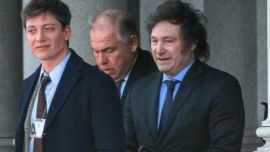
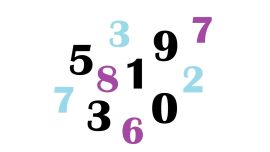



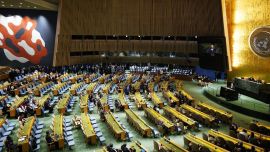
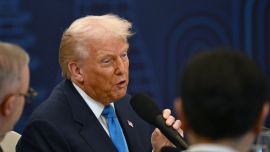


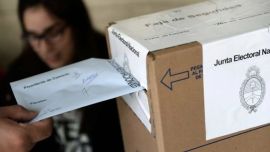

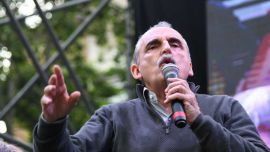

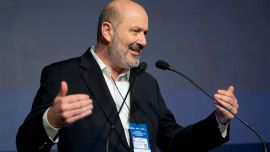
Comments